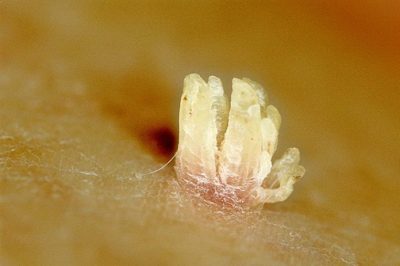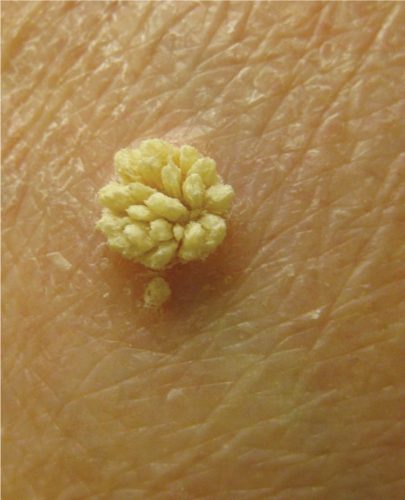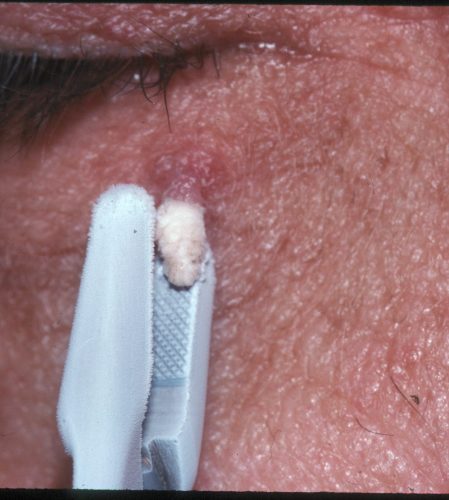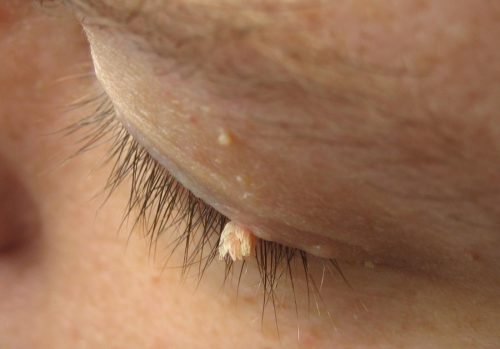admin
Latest posts by admin (see all)
- Wart Cream: Which One to Choose? - October 14, 2019
- Wart Freeze: How Does the Cryodestruction Take Place? - October 11, 2019
- How to Use Salicylic Acid for Warts Removal? - October 8, 2019
What are filiform warts, which are most often found in old age? Warts that can be found on the face and hands of our grandparents are not always unobtrusive elements. But if each person after having crossed the eighty-year-old line has this or that warty rash, especially thread-like warts, nowadays even this pathology began to rapidly grow in young people as well. These changes are associated with increased exposure to human exogenous and endogenous factors. Pollution of the world around us, constant stressful situations and other pathological agents cause premature aging of the organism, in particular – the skin, which leads to the growth of the so-called senile neoplasms.
In some periods of life a person is at greatest risk of the appearance of warts of different varieties, therefore, almost every person has had a filiform wart at least once. Filiform papillomas or acrochords are warty formations that can appear anywhere on the skin, but are more often localized in skin folds or in those places where the skin is thin skin. They have a viral nature, since the activation of the human papillomavirus leads to their appearance. Filiforms can grow after a person is infected with 3, 5, 8 and 9 types of HPV.
Contents
- What Are the Clinical Manifestations of Filiform Warts?
- How to Know that You Have a Filiform Wart Not Another Wart Type?
- Which Peculiarities Do Filiform Warts Have?
- Why Do You Have Filiform Warts?
- How to Get Rid of Filiform Warts with the Methods of the Traditional Medicine?
- Natural Ways to Prevent the Appearance of Filiform Warts:
What Are the Clinical Manifestations of Filiform Warts?
 Filiform warts can be easily distinguished from other types of skin formations by characteristic features:
Filiform warts can be easily distinguished from other types of skin formations by characteristic features:
- at the stage of formation such a papilloma looks like a small bump, similar to an ordinary birthmark;
- when it grows up, it becomes elongated, oval or round;
- acrochords are of corporal or dark brown color;
- in appearance, they resemble a ragged thread, but if at the end of such a wart is thicker, then at the base there will always be a thin leg;
- the consistency of such a papilloma is dense, but elastic;
- the length on average from 1 to 5 mm, but there are cases when filiform warts grow to 10 mm. This often happens if they are regularly traumatized;
Often, warts appear in groups but can grow one by one as well (as this usually happens with a child or a young man).
How to Know that You Have a Filiform Wart Not Another Wart Type?
Differential diagnosis in the case of filiform is not difficult: at the primary admission the dermatologist can determine the type of neoplasm based on a visual examination and procedure of dermatoscopy – increasing and studying the dermal formation under a microscope. Dermatoscopic examination makes it possible to examine in filamentous formations thrombosed vessels and angiopathy – direct signs of viral origin of the neoplasm. Sometimes, additional tests are needed to clarify some of the data: PCR diagnostics for establishing the fact of infection with human papillomavirus; biopsy of wart tissues; their histological study. All these measures are carried out to differentiate digitate warts from fibromas, moles, genital, flat, plantar and other varieties of papillomas.
Which Peculiarities Do Filiform Warts Have?
Formations of this kind are inherent in an elongated form. The name of this kind of warts was attributed to a characteristic appearance reminiscent of a torn thread, and sometimes a bundle of threads. Most threadlike warts have special properties. They can begin to grow at any age. But the priority is older age – over 60 years. Almost every elderly person is a bearer of acrochords. Most people attribute these warts to not diseases, but to skin defects of a cosmetological nature. Why should we treat them as pathologies and treat them on the most traditional clinical principles?
What is a similar pathology:
- Almost every elderly person is a bearer of filiform warts
- The reason for this phenomenon in the infection of the human body with the virus of the series 3, 5, 8 and 9 of the IF series causing such skin lesions upon ingress of microtraumas, scratches and abrasions, intertrigo and maceration of the epidermis.
- No less often, diagnosis leads to the fact that the changed genetics, hereditary disorders, the effect of congenital mutations are revealed.
- The age features also lead to a change in the metabolic functions of the body, endocrine imbalance during menopause in women. The occurrence of threadlike acrochords in the second or third trimester of pregnancy as a consequence of Rh-conflict between mother and fetus is increasingly recorded.
- The relationship between gynecological pathologies, in particular, polycysticosis in menopause and active growth of threadlike warts, has been identified, but the effect has not been adequately studied. This option has not yet been investigated
- At a respectable age, stressful conditions, prolonged nervous overstresses, work in the conditions of occupational hazards in veterans of the chemical, mining and metallurgical industries, the receipt of solid doses of radioactive radiation.
It should be remembered that warts of this type – filiform warts are not as as they may seem at first glance. In addition to the fact that they can quickly change their structure and become malignant, the digitate wart is one of the confirmations of one or another organic damage to the human body. This, in turn, is very important for diagnosing various diseases.
Why Do You Have Filiform Warts?
Threadlike warts can occur on the neck, face, and other parts of the human body are the result of HPV infection (papillomavirus). This is a very common disease, many of its types stand out. Filiform warts appear when certain types of virus penetrate the body through micro-trauma, which almost always is on the skin. Infection occurs by contact.
Sexual transmission of digitate warts is absent, infection occurs only when bodily contact with the carrier of the pathology or its things takes place.
The incubation period for this virus is large enough, activation occurs when the immune system is weakened, and this can occur under the influence of several factors. First, it is the presence of any chronic diseases. Secondly, these are stressful conditions. And, thirdly, it is hormonal dysfunction. That’s why threadlike warts often appear in women during pregnancy or during the onset of menopause. Sometimes, a large number of such neoplasms in women can indicate gynecological diseases, for example, polycystic ovaries.
How to Get Rid of Filiform Warts with the Methods of the Traditional Medicine?
 Removing the filiform wart with the help of a laser: Laser – a high-energy light beam, which when exposed to a wart literally burns it, evaporates. As a result, instead of it, you can see a small crust on the surface of the skin. After 4-5 days, the crust disappears and healthy skin appears in its place. The procedure is performed under anesthesia with lidocaine. Be sure to protect your eyes from laser radiation. Time – 30 seconds for one wart.
Removing the filiform wart with the help of a laser: Laser – a high-energy light beam, which when exposed to a wart literally burns it, evaporates. As a result, instead of it, you can see a small crust on the surface of the skin. After 4-5 days, the crust disappears and healthy skin appears in its place. The procedure is performed under anesthesia with lidocaine. Be sure to protect your eyes from laser radiation. Time – 30 seconds for one wart.- The removal by radio waves. The apparatus for radio wave surgery by its action on the skin formations resembles a laser. Evaporation of the wart tissue also occurs. The procedure is also performed under local anesthesia with lidocaine, and after it a small crust also appears. The radio wave is safe for health. The time of the procedure is 30 seconds per papilloma.
- Removal of filiform warts with liquid nitrogen. This technique has been used in medicine for 40 years. The procedure is carried out without anesthesia. The presence of a doctor is not necessary. With liquid nitrogen, a wart is cauterized, after which it dies off within a few days. After that, in its place appears healthy skin. The procedure is the cheapest of all deletion methods.
- Excision by electrocoagulation. This method is performed only by a surgeon under lidocaine anesthesia. Electronozh cuts the wart, slightly capturing healthy skin. If the wound is large, it must be sewn with threads. Now, this method is used less and less, as in all cosmetic clinics there is a laser, in the majority – a radio wave device, and in all – liquid nitrogen.
Natural Ways to Prevent the Appearance of Filiform Warts:
Filiform warts are a skin disease that occurs in old age. And at people at this age, immunity decreases. Therefore, one of the important areas in the treatment of this type of papillomas is a set of measures that increase immunity.
- Reduce stress
- Moderate physical activity
- Quenching procedures
- Refuse bad habits – smoking, alcohol
- Healthy sleep
- Healthy food – plenty of vegetables and fruits, less animal fats and meat products
- Drug intake: immunal and other
- Reception of herbal decoctions: St. John’s wort, thyme, mint, currant leaf, dogrose berries
- Baths with celandine and string
Removal of filiform papillomas is possible with the use of natural remedies.
Check the simple but effective recipes below:
- Juice of celandine. A fresh juice flows out of the yellow juice. They also smear the wart twice a day for a week. Usually during this period, education should disappear or decrease.
- On the papilloma, cut off the plastic of garlic and fix it with adhesive plaster. So repeat twice a day. After a week, usually the build-up should significantly decrease or disappear.
- This drug is a few alkalis that cause a burn of the wart tissue if it is lubricated with the drug. As a result, the burn surface gradually overgrows with normal skin. But after using it, there can be scars on the skin, if you either overdose or lubricate the surrounding skin with it.
Prevention of recurrence of the development of threadlike growths are drugs for improving immune functions, a healthy lifestyle, and a good physical shape, maintaining body hygiene. You should not forget about the preservation of positive life views and optimism in any situation!
